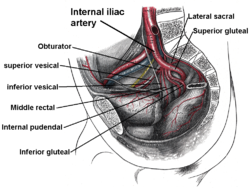| Superior vesical artery | |
|---|---|
 Male internal iliac artery and some of its branches. Superior vesical labeled at left. | |
| Details | |
| Source | Umbilical artery or anterior trunk of internal iliac artery |
| Vein | Vesical venous plexus |
| Supplies | Urinary bladder, ureter |
| Identifiers | |
| Latin | arteriae vesicales superiores |
| TA98 | A12.2.15.024 |
| TA2 | 4320 |
| FMA | 18839 |
| Anatomical terminology | |
The superior vesical artery supplies numerous branches to the upper part of the bladder. This artery often also gives branches to the vas deferens and can provide minor collateral circulation for the testicles.
YouTube Encyclopedic
-
1/5Views:481520 34941 28724 586104 160
-
Left superior vesical artery | Anatomical Terms Pronunciation by Kenhub
-
Internal Iliac Artery
-
Internal Iliac Artery / Hypogastric Artery
-
Internal Iliac Artery - Anatomy, Branches & Relations
-
How to remember the Internal Iliac Artery Branches (The 2+4+4 rule) | Anatomy
Transcription
Structure
The superior vesical artery, a vital component of the pelvic vascular system, stems from the umbilical artery, which serves as a conduit for oxygenated blood during fetal development. Emerging typically as a single vessel, the superior vesical artery exhibits consistent anatomical features across individuals. Its trajectory leads it towards the superior aspect of the bladder, where it branches intricately to supply blood to this organ and surrounding structures.
In males, a noteworthy branch arising from the superior vesical artery is the vesiculo-prostatic artery. This branch extends its reach to the prostate gland, contributing to its vascularization. The consistent presence of this arterial branch underscores its significance in male pelvic anatomy and physiology.
Distribution
Other branches supply the ureter.[further explanation needed] The superior vesical artery is a branch of the internal iliac artery. It provides blood supply to various structures in the pelvis, particularly to the bladder.
In terms of distribution, the superior vesical artery typically supplies the upper part of the bladder, including the dome and the superior surface. Additionally, it may provide branches to adjacent structures such as the ureters, seminal vesicles, vas deferens, and the ductus deferens.
The arterial supply to the bladder is crucial for maintaining its viability and proper function, as it ensures oxygen and nutrient delivery to this organ. Dysfunction or compromise of the superior vesical artery can lead to conditions such as bladder ischemia or necrosis, which can have significant clinical implications.
Variation
Anatomical variations in the branching pattern of the superior vesical artery are well-documented. Among these variations is the presence of the middle vesical artery, which traditionally arises as a branch of the superior vesical artery. The middle vesical artery typically extends its distribution to the fundus of the bladder and the seminal vesicles. Despite its potential significance in pelvic vascular anatomy, modern anatomy textbooks often omit mention of this artery, instead highlighting the variability in the number and origin of vessels supplying the bladder region.
Furthermore, variations in the origin and course of the superior vesical artery may exist, with some individuals demonstrating multiple vessels arising from a common source. These variations underscore the complex nature of pelvic vascular anatomy and emphasize the importance of thorough anatomical knowledge in clinical practice and surgical interventions.
Development
During embryonic development, the superior vesical artery derives from the umbilical artery, which serves as a vital conduit for oxygenated blood from the placenta to the developing fetus. Specifically, the initial segment of the superior vesical artery represents the terminal portion of the fetal hypogastric artery, highlighting its developmental origin from the umbilical arterial system. Understanding the embryological development of the superior vesical artery provides valuable insights into its anatomical trajectory and functional significance in the adult pelvic vasculature.
References
![]() This article incorporates text in the public domain from page 615 of the 20th edition of Gray's Anatomy (1918)
This article incorporates text in the public domain from page 615 of the 20th edition of Gray's Anatomy (1918)
The informations of this article are from.
- PubMed:
- PubMed Central
- PubMed Search
- Google Scholar:
- Google Scholar
- Embryology Textbooks (Available for Purchase or University Libraries):
- Langman's Medical Embryology
- The Developing Human: Clinically Oriented Embryology
- Online Educational Resources:
- The Anatomy Lesson by Wesley Norman
- Khan Academy
External links
- pelvis at The Anatomy Lesson by Wesley Norman (Georgetown University) (pelvicarteries)
